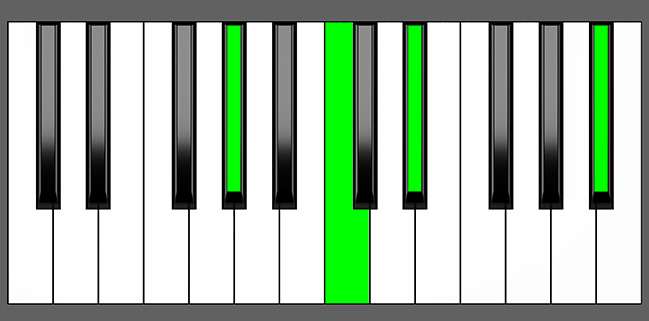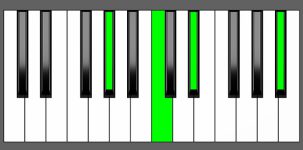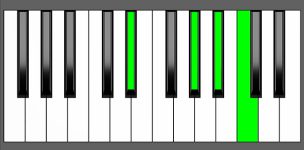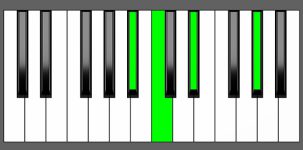Piano Diagram of Ab add9 in Root Position

To form an Ab add9 chord, you simply include a 9th note (Bb) to an Ab Major chord (Ab, C, Eb). Such chords are referred to as added tone chords as they involve the addition of supplementary intervals to a triad. The Ab add9 chord is distinct from the Ab9 chord because it doesn’t have a 7th, whereas the Ab9 chord includes the 7th note. Continue reading to discover additional information about the fundamentals of added tone chords and their applications in music.
Structure of Ab add9
Notes |
|---|
| Ab, C, Eb, Bb |
Intervals |
|---|
| R, 3, 5, 9 |
Playing Extended Chords on Piano
Extended chords can be difficult to play in their entirety on the piano due to the large number of notes involved or the distance between intervals like in this case. To simplify these chords, pianists often omit certain notes (usually the Root or the fifth) or split the chord between both hands. However, even with these simplifications, extended chords can create complex and dense harmonies, making voicing a challenging task.
Ab add9 Chord Inversions
Ab add9 chord has a total of 3 inversions:
| Root Position: | Ab | C | Eb | Bb |
| 1st Inversion: | C | Eb | Ab | Bb |
| 2nd Inversion: | Eb | Ab | Bb | C |
| 3rd Inversion: | Bb | C | Eb | Ab |
Piano Keyboard Diagrams
Chord Inversions on Piano
Chord inversions are a crucial concept in music theory as they allow for a greater understanding of how chords are constructed and how they can be used in progressions.
However, it’s important to note that the diagrams depicting the sequence of notes in a chord inversion on a piano keyboard may not always translate to practical playing.
This is because proper chord voicings involve distributing the notes of the chord across different octaves and positions on the keyboard, which may differ from the basic shape of the chord’s inversions.
Therefore, while chord inversion diagrams help understand the structure and sequence of notes in a chord, they may not always be the most efficient way to play the chord on a piano keyboard.
Music Theory and Harmony of Ab Add 9
Building the Ab add9 Chord: Different Approaches
Starting from the Ab Major Scale:
To build an Add 9 chord, begin by using the Major scale as a reference and selecting the Root, 3rd, 5th, and 9th notes.


Here are the steps to get the Ab add9 chord using the formula R, 3, 5, 9:
- Begin with the Root note, which is Ab.
- Add the 3rd note, which is C.
- Include the 5th note, which is Eb.
- Finally, add the 9th note, which is Bb.
by Combining Intervals:
Another approach to building an Add 9 chord involves combining particular intervals, such as a major 3rd, minor 3rd, and perfect 5th.
3 + m3 + 5 = add9 chords
For example, to create an Ab add9 chord, you can layer
- Ab-C (a major 3rd),
- C-Eb (a minor 3rd),
- and Eb-Bb (a perfect 5th) on top of each other.
How to Use Ab add9 in a Chord Progression
In music theory, the concept of harmonic function refers to the role a chord plays in a musical composition. A stable harmonic function is associated with a chord that provides a sense of rest or resolution, while a dominant harmonic function creates a sense of tension or instability that often leads to a resolution to a stable chord.
The harmonic function of an Ab add9 chord is not fixed and can vary based on the surrounding harmonic context and the musical composition. For instance, when an Ab add9 chord follows a dominant chord like Eb7, it functions as a stable chord that resolves the preceding tension.
However, in other situations, such as in a chord progression in the key of Db major, the Ab add9 chord can serve as a dominant chord.
It is helpful to explore which scales and degrees include an Ab Maj7 or Ab7 chord, which can potentially be substituted with an Ab add9 chord.
on Major Scales
| Major Scales | I | ii | iii | IV | V | vi | vii |
|---|---|---|---|---|---|---|---|
| Ab | Ab Maj7 ⇒ Ab add9 | Bb min7 | C min7 | Db Maj7 | Eb7 | F min7 | Gm7b5 |
| Eb | Eb Maj7 | F min7 | G min7 | Ab Maj7 ⇒ Ab add9 | Bb7 | C min7 | Dm7b5 |
| Db | Db Maj7 | Eb min7 | F min7 | Gb Maj7 | Ab7 ⇒ Ab add9 | Bb min7 | Cm7b5 |
- Tonic chord in Ab Major
- Subdominant chord in Eb Major
- Dominant chord in Db Major
on Natural minor Scales
| Minor Scales | i | ii | III | iv | v | VI | VII |
|---|---|---|---|---|---|---|---|
| F | F min7 | Gm7b5 | Ab Maj7 ⇒ Ab add9 | Bb min7 | C min7 | Db Maj7 | Eb7 |
| C | C min7 | Dm7b5 | Eb Maj7 | F min7 | G min7 | Ab Maj7 ⇒ Ab add9 | Bb7 |
| Bb | Bb min7 | Cm7b5 | Db Maj7 | Eb min7 | F min7 | Gb Maj7 | Ab7 ⇒ Ab add9 |
- Mediant chord in F minor
- Submediant chord in C minor
- Leading tone chord in Bb minor
Ab add9 Chord Function in Major and Minor Keys
Understanding Scale Degrees
When harmonizing a scale, you create chords using the notes from that scale. Each note in the scale is assigned a degree, reflecting its position in the scale. In the diatonic major scale, the degrees are as follows:
- Tonic: This is the first degree of the scale and provides a stable tonal center. It’s often referred to as the “home base” of the music.
- Supertonic: This is the second degree of the scale and is frequently used as a passing note between the tonic and other scale degrees.
- Mediant: This is the third degree of the scale and helps to establish whether the scale is major or minor. It’s located halfway between the tonic and dominant notes.
- Subdominant: This is the fourth degree of the scale and is often used as a complementary harmony to the dominant.
- Dominant: This is the fifth degree of the scale and generates tension and a sense of expectation. It’s typically resolved by returning to the tonic.
- Submediant: This is the sixth degree of the scale and is often utilized as a transition between the dominant and tonic.
- Leading tone: This is the seventh degree of the scale and is located one half-step below the tonic. It produces a strong sense of tension and a desire to resolve to the tonic.
Understanding the scale degrees is important for creating chords and understanding how they relate harmonically to each other.
Ab add9 in Ab Major
You can use an Ab add9 chord as a substitution for the Ab major or Ab major 7th chord, which is the first chord in the harmonized Ab major scale.
In a major key, the first chord (I chord) built on the first degree of the major scale serves as the tonic chord, creating the harmonic center of the chord progression.
| I | ii | iii | IV | V | vi | vii |
| Ab Maj7 ⇒ Ab add9 | Bb min7 | C min7 | Db Maj7 | Eb7 | F min7 | Gm7b5 |
Ab add9 Chord Progressions as I degree
Incorporating an add9 chord in your music can add an element of intrigue and variation. It can be used as a substitute for a traditional major chord or as a modulation towards a more stable Ab Major chord. For instance, try using the Ab add9 chord as the first chord in a progression and see how it affects the overall sound.
ii V I
| ii | V | I |
| Bb min7 | Eb7 | Ab add9 | Ab Maj7 |
I IV V
| I | IV | V |
| Ab add9 | Ab Maj7 | Db Maj7 | Eb7 |
I V vi IV
| I | V | vi | IV |
| Ab add9 | Ab Maj7 | Eb7 | F min7 | Db Maj7 |
I IV vi V
| I | IV | vi | V |
| Ab add9 | Ab Maj7 | Db Maj7 | F min7 | Eb7 |
Ab add9 in Eb Major
You can also use the Ab add9 chord as a substitute for the Ab major 7th chord when it appears on the fourth degree of the Eb major scale. This substitution can be employed in the I-IV-V chord progression, with the add9 chord on the fourth degree acting as a transitional chord between the first and fifth degrees.
| I | ii | iii | IV | V | vi | vii |
| Eb Maj7 | F min7 | G min7 | Ab Maj7 ⇒ Ab add9 | Bb7 | C min7 | Dm7b5 |
Ab add9 as IV degree – Chord Progressions
Try experimenting with chord progressions that use an Ab add9 chord instead of the typical Ab Maj7 chord on the fourth degree in the Eb major scale. This substitution can add some variety and interest to the common I-IV-V progression, where the add9 chord can act as a transitional chord between the first and fifth degrees.
I IV V
| I | IV | V |
| Eb Maj7 | Ab add9 | Ab Maj7 | Bb7 |
I V vi IV
| I | V | vi | IV |
| Eb Maj7 | Bb7 | C min7 | Ab add9 | Ab Maj7 |
I IV vi V
| I | IV | vi | V |
| Eb Maj7 | Ab add9 | Ab Maj7 | C min7 | Bb7 |
Ab add9 in Db Major
Another way to incorporate the Ab add9 chord into music is by using it as a substitution for the dominant chord in the key of Db major.
In this case, the Ab add9 chord can be seen as a variation of the Ab Major 7 chord, which serves as the fifth degree of the Db major scale. When played in a ii-V-I progression, the Ab add9 chord on the fifth degree can function as the dominant chord that leads to the resolution on the first degree.
While this may not be the most conventional use of the Ab add9 chord, it’s worth noting that the 9th (Bb) corresponds with the 5th of the ii degree (Eb min7) and with the 6th of the Db major chord, creating an interesting resolution towards the fifth note (Ab) of the tonic chord.
| I | ii | iii | IV | V | vi | vii |
| Db Maj7 | Eb min7 | F min7 | Gb Maj7 | Ab7 ⇒ Ab add9 | Bb min7 | Cm7b5 |
Ab add9 as V degree – Chord Progressions
To hear how the add9 chord can work as a substitute for the dominant (V degree) in a chord progression, you can experiment with playing the following chord progression: start with the 3rd inversion of Eb min7, which includes the notes Db, Eb, Gb, and Bb; then move to the root position of Ab add9, which includes the notes Ab, C, Eb, and Bb; and finally play the 3rd inversion of Db Maj7, which includes the notes C, Db, F, Ab.
ii V I
| ii | V | I |
| Eb min7 | Ab add9 | Ab7 | Db Maj7 |
I IV V
| I | IV | V |
| Db Maj7 | Gb Maj7 | Ab add9 | Ab7 |
I V vi IV
| I | V | vi | IV |
| Db Maj7 | Ab add9 | Ab7 | Bb min7 | Gb Maj7 |
I IV vi V
| I | IV | vi | V |
| Db Maj7 | Gb Maj7 | Bb min 7 | Ab add9 | Ab7 |
I IV ii V iii vi ii V
| I | IV | ii | V | iii | vi | ii | V |
| Db Maj7 | Gb Maj7 | Eb min7 | Ab add9 | Ab7 | F min7 | Bb min7 | Eb min7 | Ab add9 | Ab7 |
Ab add9 in F minor
In the key of F minor, you can use the Ab add9 chord as a substitution for the Ab Maj7 chord, which serves as the third degree in the scale.
| i | ii | III | iv | v | VI | VII |
| F min7 | Gm7b5 | Ab Maj7 ⇒ Ab add9 | Bb min7 | C min7 | Db Maj7 | Eb7 |
Ab add9 as III degree – Chord Progressions
The following chord progressions showcase how the Ab add9 chord can be used as a variation of the mediant (III degree) chord.
i III
| i | III |
| F min7 | Ab add9 | Ab Maj7 |
i III VII VI
| i | III | VII | VI |
| F min7 | Ab add9 | Ab Maj7 | Eb7 | Db Maj7 |
Circle Progression
| i | iv | VII | III | VI | vii | V7 | i |
| F min7 | Bb min7 | Eb7 | Ab add9 | Ab Maj7 | Db Maj7 | Gm7b5 | C7 | F min7 |
(A progression that follows the circle of fifths is a sequence of chords that move in ascending or descending fifths from one key to another. It’s called a “circle” progression because if you keep moving through the sequence, you’ll eventually come back to the starting point, creating a “circle” of keys.)
Ab add9 in C minor
In the key of C natural minor, the add9 chord can also be used as a substitution for the chord on the sixth degree, which is Abmaj7.
| i | ii | III | iv | v | VI | VII |
| C min7 | Dm7b5 | Eb Maj7 | F min7 | G min7 | Ab Maj7 ⇒ Ab add9 | Bb7 |
Ab add9 as VI degree – Chord Progressions
To better understand how the add9 chord can be used as a substitute for the Ab Maj7 chord when it functions as the submediant (VI degree) in a C minor scale, you can experiment with the following chord progressions:
i VI VII
| i | VI | VII |
| C min7 | Ab add9 | Ab Maj7 | Bb7 |
i v VI VII
| i | v | VI | VII |
| C min7 | G min7 | Ab add9 | Ab Maj7 | Bb7 |
i III VII VI
| i | III | VII | VI |
| C min7 | Eb Maj7 | Bb7 | Ab add9 | Ab Maj7 |
Ab add9 in Bb minor
Another way to use the Ab add9 chord is as a substitution for the leading tone chord in the key of Bb minor. In this context, the Ab add9 chord functions as a variation of the Ab7 chord, serving as the VII degree of the Bb natural minor scale.
| i | ii | III | iv | v | VI | VII |
| Bb min7 | Cm7b5 | Db Maj7 | Eb min7 | F min7 | Gb Maj7 | Ab7 ⇒ Ab add9 |
Ab add9 as VII degree – Chord Progressions
Play the following chords to hear how the Ab add9 works as a substitution for the leading tone (VII degree) in a chord progression.
I suggest playing the first inversion of Bb minor 7 (Db, F, Ab, Bb), the second inversion of Gb Major 7 (Db, F, Gb, Bb), and the root position of Ab add9 (Ab, C, Eb, Bb).
By using these chords, the highest note in each chord will be a Bb, which creates a consistent and stable sound. Then, you can transition from the Ab add9 chord to an Ab major chord by simply moving the ninth (Bb) down to an Ab note. This can help you hear how the Ab add9 chord functions as a substitute for the leading tone (VII degree) in a chord progression.
i VI VII
| i | V | VII |
| Bb min7 | Gb Maj7 | Ab add9 | Ab7 |
i v VI VII
| i | v | VI | VII |
| Bb min7 | F min7 | Gb Maj7 | Ab add9 | Ab7 |
i III VII VI
| i | III | VII | VI |
| Bb min7 | Db Maj7 | Ab add9 | Ab7 | Gb Maj7 |
Add9 and Add2 Chords: Similarities and Differences
Add9 and add2 chords are similar in that they both contain the second note of the major scale as an additional note to the basic triad. However, the difference between the two is that the add9 chord includes the second note an octave higher, whereas the add2 chord includes the second note as it is in the scale.
The Debate Around Add2 and Add4 Chords
There is some debate about the usefulness of add2 and add4 chords as distinct entities.
Add2 chords are made by:
- the Root,
- the 2nd,
- the 3rd,
- and the 5th,
while add4 chords are made by:
- the Root,
- the 3rd,
- the 4th
- and the 5th.
These chords can sound pretty dissonant in their root position due to the cluster of notes they create. However, playing the 2nd or 4th note at a higher octave can help reduce the dissonance.
To achieve a more harmonically pleasing sound, it’s better to use add9 and add11 chords, which still include the desired note.
If we really need to add a 2nd or 4th note, we should omit the 3rd, which is exactly what suspended chords (sus2 and sus4) are designed for.
Alternative Names for Ab add9 Chord
- Ab add9
- Lab add9
- Ab (add9)
- Ab add(9)
- Ab add 9th
Conclusion
The chord progressions and examples presented in this post provide a comprehensive overview of the most common uses of the Ab add9 chord. It’s important to note, however, that many advanced harmony-related topics could not be included due to space constraints. These topics include chord progressions built on harmonic and melodic scales, modal scales, hidden tonality, secondary dominants and other chord substitutions, non-functional harmony and atonal music, modal interchange and borrowed chords, voice leading and counterpoint, chromatisms, jazz harmony…I mean, music theory is a huge topic!
Although I couldn’t cover all of these topics in my post, I encourage readers to continue exploring these areas in their own study and research. By expanding your knowledge in these advanced areas of music theory, you can gain a deeper understanding of the harmonic possibilities that exist beyond the basics presented here.



